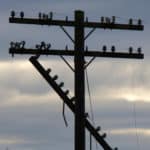10 Reasons for Power Grid Failure
This post may contain affiliate links. Read my full disclosure here.
Our electric grid is aging, and electric demand is increasing. We review 10 reasons for brownouts and power grid failure.

Table of contents
What Causes Power Grid Failure?
There are a number of causes for power grid failures. Some are acts of nature, some are human error, and others are issues inherent in the technology.
Low to Medium Impact with High Frequency
- Weather, including ice and high winds
- Earthquakes and other natural disasters
- Increased demand
- Intentional/Planned Outages
- Human Error
- The aging power grid
- Renewable energy problems
High Impact with Low Frequency
- Physical Attack
- Cyber Attacks
- Solar CME & Nuclear EMP
Weather
Inclement weather is the main reason for power outages. Winter storms, snowstorms, tornadoes, hurricanes create damaging winds or debris that take down transmission lines. Lines down result in the power grid failing for periods of time in a local area.
Extreme weather such as very cold or very hot weather can cause spikes in demand that exceed available power and overwhelm the system. Winter weather and ice storms regularly take down power lines, too.
Earthquakes and Other Natural Disasters
Earthquakes damage infrastructure, primarily in California, which sees frequent earthquakes. All states have had an earthquake at some point, but they are less common.
The New Madrid runs through the center of the United States. In 1811- 1912, there were a series of large earthquakes in the Midwest.
The other major natural disaster that causes outages is flooding. High storms winds coupled with heavy rain can be enough to tip over poles or damage equipment.

Increased Demand
Over the past decade, rolling blackouts and brown outs have occurred because demand is higher than the available power supply.
We have not built many baseline power plants. In fact, we have shut many down, instead building peaking plants powered by wind and solar, which cannot sustain power if the baseline power plants are offline.
Intentional Outages
Government and power companies sometimes attempt to reduce fire risk by causing intentional outages, shutting the power grid down in certain areas. Sometimes the electricity supply is cut off during repairs and maintenance.
Human Error/Disasters
There was a “software bug” power outage in 2003. Roughly 10 million people in Ontario and 45 million people in eight U.S. states lost power.
9/11 is another example of a disaster that impacted services including regional phone services, transportation, and the power grid.
Aging Power Grid
The power grid today, experiences 2.5x more outages than it did in 1984. We are seeing power line failures, substation failures and numerous other random failures throughout the grid. The average age of the grid is 32 years old.
- What an aging power grid means for US Supply Chains
- Scorching heat, rolling blackouts: The West is changing how it does summer
- The Grid’s Big Looming Problem
Renewable Energy Problems
Renewable energy power systems such as solar and wind don’t work if the sun isn’t out or the wind isn’t blowing. Germany is experiencing this problem in Jan 2022 because of lack of energy related to too much reliance on solar and wind.
Renewable energy sources and other “peaking plants” require a “baseline” sine wave to synchronize with for transmission. That baseline is provided by large nuclear or coal primary power generation.
The smaller solar and wind renewable energy systems don’t have anything to sync with if those baseline sources are unavailable or offline. This means they are unable to provide power even if it is sunny or windy. Some more advanced ones can create their own sine wave, but that has its issues also.
Electric cars also represent a new risk, since they require enormous amounts of electricity to recharge. California power companies have already issued requests not to charge.
Would you like to save this?
Physical Attack
There are 2000+ EHV (extra high voltage) transformers in the USA and most have little to no protection. EHV transformers require 12 to 24 months to manufacture, and they don’t keep many spares in stock.
Neither the utilities or the government have enough transformers on hand to replace damaged ones if there is any sort of mass attack.
Examples of physical attacks:
- Tennessee Valley Authority had five incidents between 2011 and December 2014
- On April 16, 2013 a PG&E’s 500 kV substation (EHV transformers) in Coyote, California were attacked. Gunfire destroyed one of the larger transformers and damaged 16 others.
- Cabot outages in August and Scott in Sept and Oct 6 of 2013 in Arkansas (all by the same person)
- In 2017 a Garkane Energy’s (Utah) substation was attacked. More info here.
- December 2017 in Arizona
- 2019 Randolf County NC, man arrested for shooting an electrical transformer
- Feb 2022 three men were caught and plead guilty to planning grid attacks. More info here
- July 2022, Huron, South Dakota had transformers “vandalized”
- On Saturday Dec 3rd 2022 two substations in North Carolina were attacked. Details here
Cyber Attacks
The US utility grid face constant cyber attacks, it is likely the hackers will eventually succeed and do something very bad.
In 2007 Idaho National Laboratory performed the Aurora Generator Test, which demonstrated how a Cyberattack could cause physical destruction of critical components of the electric grid.
Cyber attack events
- Hackers successfully attacked Colonial Pipeline in May of 2021.
- During Christmas 2015/2016 and again in 2016/2017 – Russia successfully cut power to 250,000 people in Ukraine. This included a denial of service on the Ukraine version of 911 services and disruption of electrical systems.
- Widespread cyber attacks by RedEcho (China) on Indian power (DLT, Telangan, etc.)
- Colonial Pipeline attack
- The thwarted Saudi Aramco attack
- 2014 Korea Hydro and Nuclear Power (KHNP) hack.
Solar CME and Nuclear EMP
Solar CME (Coronal Mass Ejection). A small CME or Solar Flare hit Canada and parts of the Northern US in 1989, resulting in serious damage to a small part of the grid. A larger event such as the 1869 Carrington event would be devastating.
Unfortunately, it is only a matter of time before we get hit with a big coronal mass ejection. We missed a major solar flare by 9 days in 2012, one that was at least as big as the Carrington event.
Nuclear EMP (electro magnetic pulse) – A nuclear explosion will result in a blast that emits a pulse that severely damages the power grid.
In 1994, Russian scientists shared information regarding a nuclear test. The test was to determine the results of an EMP. The test was detonated over an industrial area of Kazakhstan with a population of 148,000.
The Russian nuke destroyed a 600-kilometer buried power line and started fires in the city’s electrical power plant. It also damaged or destroyed generators transmission lines.
The Starfish prime nuclear test was visible 900 miles away. The EMP did damage to radios and telephones. Even strings of streetlights failed on the island of Oahu failed. Less well known is that six satellites were damaged by the EMP also.
Any large CME or EMP would cause widespread power grid failure.
Power Grid Zones
The North American power grid is a complex service that includes the US & Canada. It is roughly broke into 7 interconnected grids (see diagram).
United States Power Grid Zones – Source ERCOT
Grid outages can impact natural gas service if the natural gas is delivered via electric pumps. Bad weather can interrupt natural gas delivery to power plants if the gas comes in via truck.
What can I do to help make the grid more reliable?
Talk to your elected officials about improving the power grid. Suggest requiring more distributed BASELINE generation and at least 5% excess capacity.
Demand that civilian critical power generation infrastructure is protected & hardened just like the military. Require formal “restart” procedures for grid operations and physical protection of critical infrastructure.
You can also prepare, see – When the Power Goes Out – 12 Things You Need to Prepare.
The good news is that there is more distributed power generation. The bad news is we still don’t have enough “excess” capacity – which is most important in outages and supplementing when renewable sources are offline.
Power grid failures and risks references links
- PG&E power outages could continue for a decade
- Heat wave sparks major power outages around Los Angeles
- ‘Massive Failure’ in Power Grid Causes Blackout in Argentina and Uruguay
- Electric grid ‘prime target’ of terrorists, ‘profound threat,’ says DHS
- Over a Quarter of the U.S. Nuclear Plants Are at Risk for Retirement
- Aging US Power Grid Blacks Out More Than Any Other Developed Nation
Related Articles

This post was written by August Neverman IV. August has a strong background in emergency preparedness. He served on several emergency preparedness teams during his tenure at Brown County WI Government, the Medical College of Wisconsin, HSHS, a 13-hospital system and emergency response training during his time with the Air Force and Air National Guard. Learn more about August.


🤣🤣🤣 As I sit here listening to our generator humming away…
A couple of years ago we had a storm that took out the power for almost a week in the summer. I was annoyed at the time, but now realize it was a great way to see what we were doing correctly, or what we needed to improve on.
There’s nothing like an extended power outage to help you re-evaluate everything with a fresh perspective. Sometimes what seem like small things can turn into a major issue, especially with extended outages. I’m glad you used it as a learning experience, and hope you don’t have to go through it again soon.
The few “grid down” experiences I have had left me with an assessment that grid operators are in general heroes of our electronic times. Nonetheless, I like the action steps in the “What Can I Do…” section. The volume of regulation it takes to run any utility is intimidating, but I have found that contacts and requests to utilities of various kinds are met with civility and typically, a genuine interest on their part in discovering a new area of concern or suggestions for improvement.
Kent, a reader on Facebook noted we missed animals. We definitely missed that. Thanks Kent. Animals create localized outages and in rare circumstances regional outages. The animals end up creating a circuit that should not exist and short out service and sometimes damage transformers or even substations in the process.
Another reader noted car accidents. Again a local event usually taking down a telephone pole, which results in a power lines getting cut. If you even are involved in an accident with power lines STAY IN YOUR CAR.
If we missed other reasons for power outages please let us know!
If I have learned anything from the occasional power outages we have here in Mississippi, is that we SHOULD have back-ups for back-ups. Most small generators are not exercised (run) monthly or even yearly in our area. Many whole house automatic standby propane powered generators only have stored fuel capacity for LESS than a week. A 500 gallon propane tank costs $3/gallon to refill PLUS $100 EXTRA for a weekend delivery. A 20kw generator uses about 2 gallons/hr depending on load. You get the picture !
We are seriously thankful for the out of state linesmen that restored our power after a week-long weather related outage in June this year.